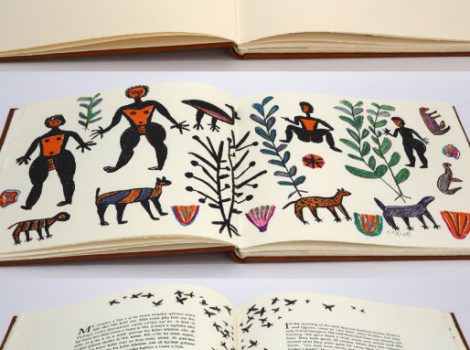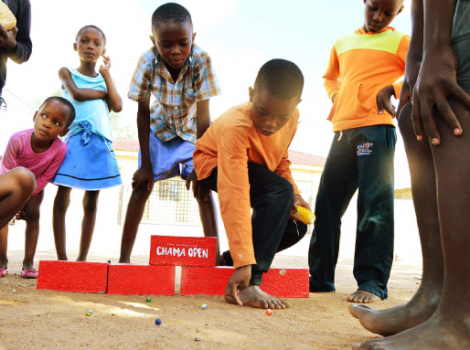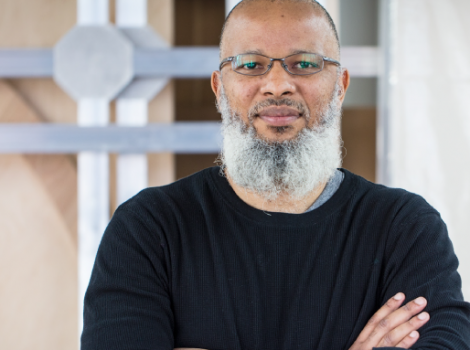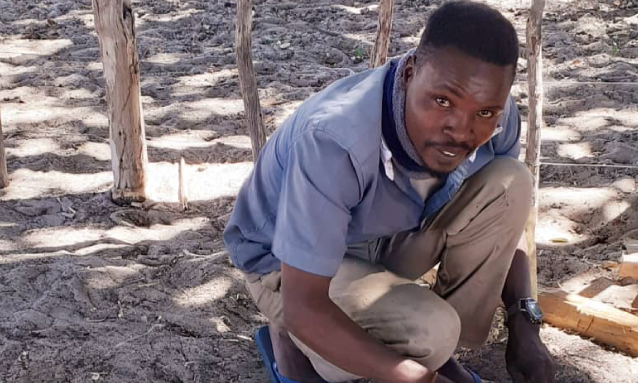
Africa’s iron-smelting culture goes back over 1000 years and in the Delta areas, this culture is retained in the form of a bladesmithing cottage industry. Communities in these areas prefer locally-made cutting tools over factory-made ones. Factory-made ones are considered heavy and not as easy to manipulate. As such, beyond its symbolic value as part of the people’s cultural heritage, the blade-smithing tradition also has practical everyday use.
How it’s done
Materials required for this cottage industry are quite basic – a bare-ground forge consisting of two bellows, each with an upright wooden-stick handle attached to the upper end; two wooden tubes called tuyeres; a conical funnel (called “dikera” in Thimbukushu) that consolidates air blast from the tuyeres; and, a small lump of charcoal fire that is kept burning at an extremely high temperature in the fire pot. Making “dikera” is laborious, bone-grinding work, one that also requires in depth-knowledge of highly complex materials engineering. This device is made with a mixture of almost mineral-rare clay that is colloquially called “Omang”, lump charcoal, animal bones and recycled car oil.
This clay, which has unusually good binding strength, can be dug out from under quicksand. The latter is most common in and along delta rivers. The clay and bones are pyrolysed (burnt to ashes in order to change their chemical composition) and together with the charcoal, ground into a fine powder. The car oil moistens the powdery charcoal so it’s not blown away by wind. These materials are mixed into a paste of medium thickness, which is then cast into a cone that has a wide opening to which the tuyeres are attached and a smaller one that projects into the fire pot. The cone is left out in the sun to air dry for a day, thoroughly inspected for cracks. If any cracks are found, they are sealed with the leftover paste from the mixture. When the sealant has dried, the cone is fired in a kiln.
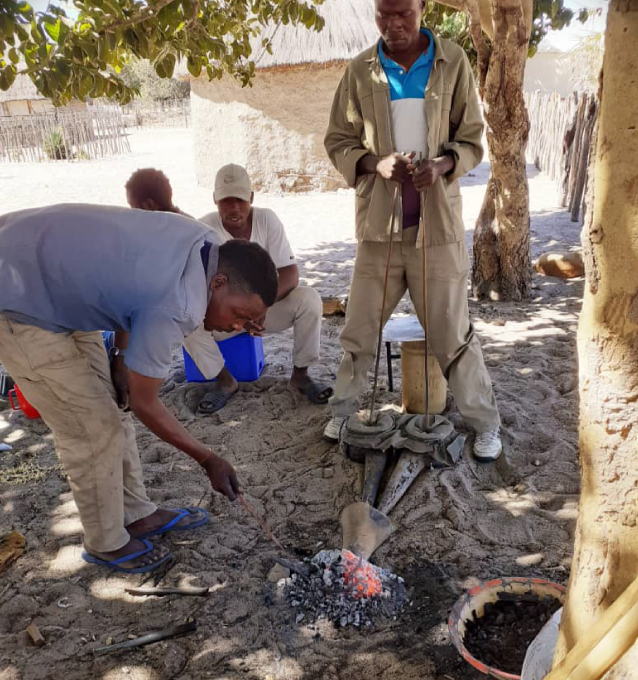
Two separate wooden chunks cut from the trunk of a Mukwa tree (otherwise known as African teak), which are connected by a hole form the main part of the forge. The tuyere branches have to be of a suitable branching angle. The bellows are made by chiselling out the trunk to form a bowl-like depression while the tuyere is made by hollowing out the pith of the branch with a sharp hot metal rod.
The bellows are handworked with a series of upward and downward strokes to generate a strong blast of air that flows through the tuyeres and is funnelled into a charcoal-fed fire into which the piece of cast iron to be forged has been placed. This steady supply of air maintains the temperature of the fire at a suitably high level, making the iron hot enough to be forged. The iron is shaped with a hammer on an anvil while it is still red hot.
The ingenuity of Okavango bladesmiths
A bellow is a bowl-like receptacle hewn from the trunk of a Mukwa tree and covered with a rectangle of whatever canvas material will do the job – see picture below. The canvas is folded in such manner that there are flaps which open on the upstroke of the hand and close on the downstroke, trapping air and forcing it through the tuyeres. Cordage of suitable strength and length is used to bind the canvas in place. In the past when there were little to no restrictions on pot hunting, impala skin was used to cover the bellows because of its soft quality.
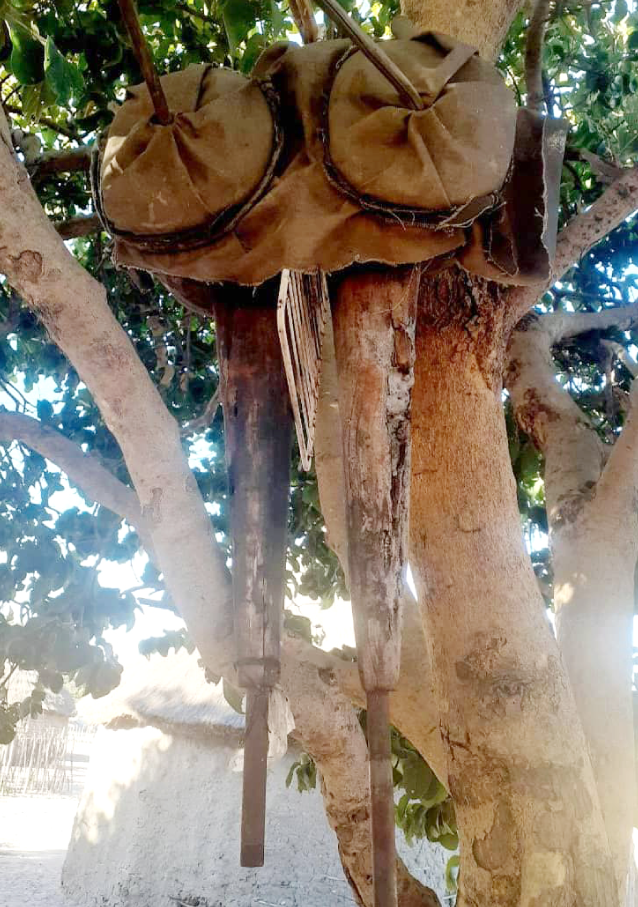
The ingenuous Okavango bladesmiths make the most of everything around them – the Mophane bee produces dark-coloured nectar that is called “wiki” in Thimbukushu, “wukume” in Shiyeyi but remains eponymous (is called by the same name) in Setswana. After extracting the nectar from the comb, the wax, which has excellent binding strength and a relatively low melting point range, is moulded into blocks like this one shown below.
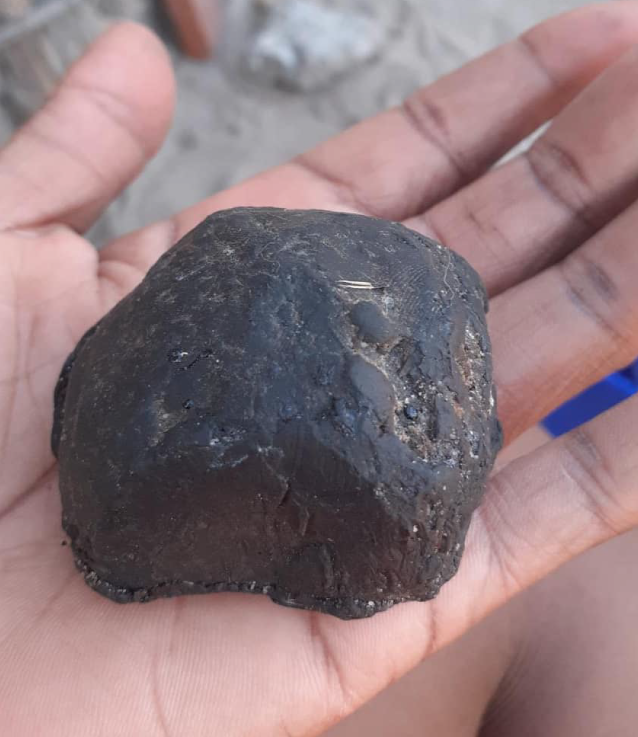
The wax, called “dinongo” in Thimbukushu, is melted over the fire and its paste applied to the surface of a cutting tool handle. Serving as both coating and glazing agent, the wax seals out the air to prevent water loss, protects the wood surface against damage and gives the handle excellent strength. The handle of the Delta cutting tools is made from “Mogonono” – Silver Cluster Leaf tree while the shoulder of the handle is varnished with the wax of Mophane bee.
The fire pot is fed with lump charcoal from “Mogotlho” – Camel Thorn tree. The quality of “Mogotlho” charcoal is such that it sparks less, burns hotter, produces more coals and has a low ash yield. These qualities make it ideal for generating extremely high temperatures that blade-smithing requires. The University of Botswana and the Department of Energy have done research that shows the amount of heat produced by wood from various species of indigenous trees when burned.
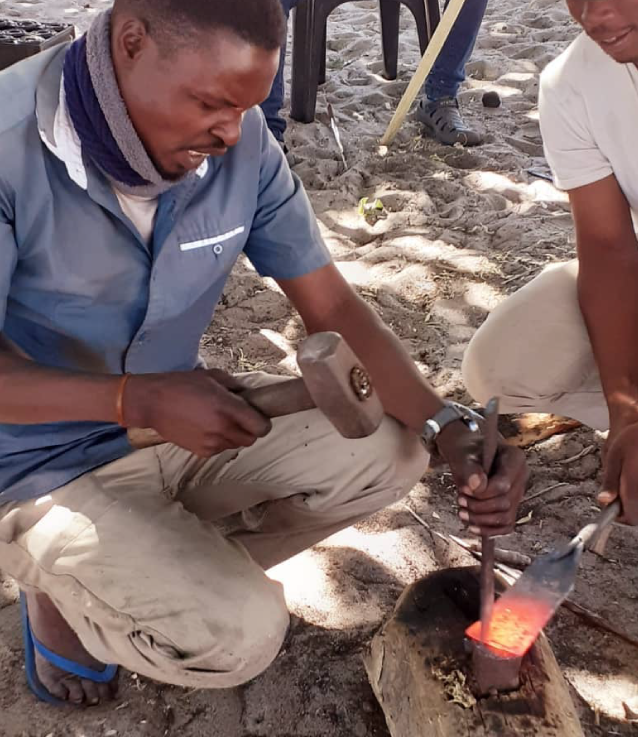
A missed opportunity?
According to the Culture Botswana 2.0 Facebook page, amazing as this is, “the government has taken no real interest in either cultural tourism or indigenous knowledge, paying lip service to citizen economic empowerment related to both.” The page maintains that as a form of cultural tourism, the Okavango Delta blade-smithing tradition would greatly empower local communities, especially because they would be in firm control of this economic sub-sector.
More importantly, this culture is imbued with unique indigenous scientific knowledge, notably metallurgy and materials engineering. Culture Botswana argues;
“Despite the hype, the government has a long-standing neo-colonial orientation to knowledge and the default stance of its human resource policies is to invalidate indigenous knowledge. The bladesmiths depicted here are never going to make it onto the official scarce-skill cadre list despite the fact that even in the Delta, there are very few people who possess this unique and highly sought-after skillset.
For what it’s worth, we learn that the Delta’s high-performance cutting tools are also becoming popular outside Ngamiland.”
Culture Botswana says people in the Delta consider factory made cutting tools too heavy and the cheeks (sides of axe head) too thick to effectively cut into wood or earth. The Okavango bladesmiths have sought to correct this complaint by making slimmer, less clunky tools.
See how they do it
Culture Botswana shared the video to show bladesmithing activity at forges in two different Okavango Delta villages, Beetsha and Seronga.
The seated man pumping the bellows in the first part of the video is called Mathata Molatlhegi. He had come to Kebafitlhetse “Delta” Mokena’s forge as a customer, Molatlhegi decided to speed up the process by helping out. Mokena is the man applying black wax to the wooden handle. The conversation you hear is in Thimbukushu, the language of the Hambukushu, whose highest geographic concentration is in the Delta. The Seronga forge is worked by a young, primary school-going boy, Ofentse Mavuna, who is still being taught the trade. There is every indication that Ofentse will qualify as a bladesmith before he completes his formal education.
Disclaimer: The views and opinions expressed in this article are those of the authors and do not necessarily reflect the official position of YourBotswana.
Source & imagery: Culture Botswana 2.0 Facebook page
About Culture Botswana 2.0 – A unique nation-building tool, Culture Botswana 2.0 champions cultural diversity, inclusion, equality and visibility through indigenous-culture journalism that documents and dignifies all of Botswana’s indigenous cultures.Credits
Beetsha clip: Tshepo Botshelo / Seronga clip: Rogers Kesietswe / Background music for Seronga clip: Impromptu performance by Gunotsoga residents as recorded by John Keesi of the Kamanakao Association

